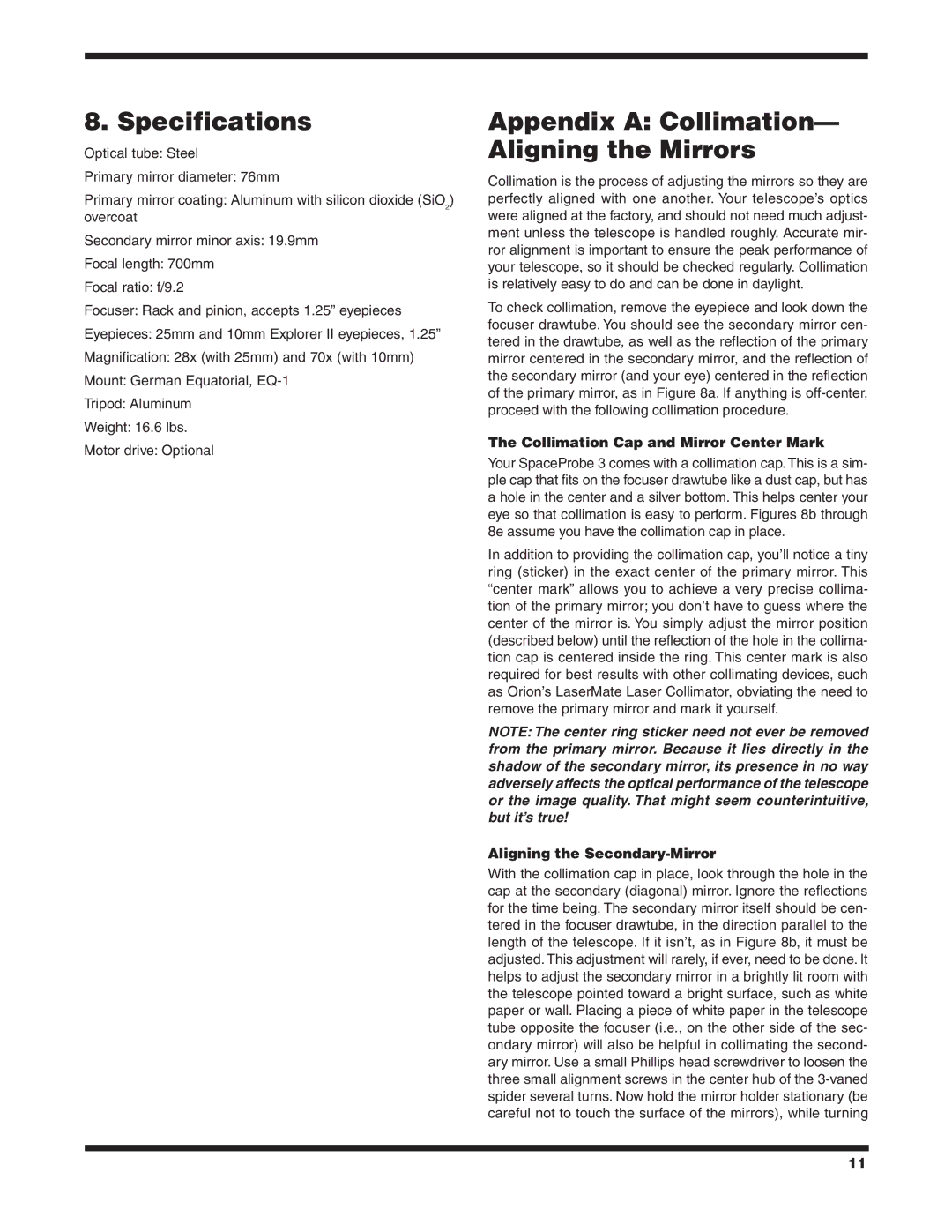
8. Specifications
Optical tube: Steel
Primary mirror diameter: 76mm
Primary mirror coating: Aluminum with silicon dioxide (SiO2) overcoat
Secondary mirror minor axis: 19.9mm
Focal length: 700mm
Focal ratio: f/9.2
Focuser: Rack and pinion, accepts 1.25” eyepieces
Eyepieces: 25mm and 10mm Explorer II eyepieces, 1.25”
Magnification: 28x (with 25mm) and 70x (with 10mm)
Mount: German Equatorial,
Tripod: Aluminum
Weight: 16.6 lbs.
Motor drive: Optional
Appendix A: Collimation— Aligning the Mirrors
Collimation is the process of adjusting the mirrors so they are perfectly aligned with one another. Your telescope’s optics were aligned at the factory, and should not need much adjust- ment unless the telescope is handled roughly. Accurate mir- ror alignment is important to ensure the peak performance of your telescope, so it should be checked regularly. Collimation is relatively easy to do and can be done in daylight.
To check collimation, remove the eyepiece and look down the focuser drawtube. You should see the secondary mirror cen- tered in the drawtube, as well as the reflection of the primary mirror centered in the secondary mirror, and the reflection of the secondary mirror (and your eye) centered in the reflection of the primary mirror, as in Figure 8a. If anything is
The Collimation Cap and Mirror Center Mark
Your SpaceProbe 3 comes with a collimation cap. This is a sim- ple cap that fits on the focuser drawtube like a dust cap, but has a hole in the center and a silver bottom. This helps center your eye so that collimation is easy to perform. Figures 8b through 8e assume you have the collimation cap in place.
In addition to providing the collimation cap, you’ll notice a tiny ring (sticker) in the exact center of the primary mirror. This “center mark” allows you to achieve a very precise collima- tion of the primary mirror; you don’t have to guess where the center of the mirror is. You simply adjust the mirror position (described below) until the reflection of the hole in the collima- tion cap is centered inside the ring. This center mark is also required for best results with other collimating devices, such as Orion’s LaserMate Laser Collimator, obviating the need to remove the primary mirror and mark it yourself.
NOTE: The center ring sticker need not ever be removed from the primary mirror. Because it lies directly in the shadow of the secondary mirror, its presence in no way adversely affects the optical performance of the telescope or the image quality. That might seem counterintuitive, but it’s true!
Aligning the Secondary‑Mirror
With the collimation cap in place, look through the hole in the cap at the secondary (diagonal) mirror. Ignore the reflections for the time being. The secondary mirror itself should be cen- tered in the focuser drawtube, in the direction parallel to the length of the telescope. If it isn’t, as in Figure 8b, it must be adjusted. This adjustment will rarely, if ever, need to be done. It helps to adjust the secondary mirror in a brightly lit room with the telescope pointed toward a bright surface, such as white paper or wall. Placing a piece of white paper in the telescope tube opposite the focuser (i.e., on the other side of the sec- ondary mirror) will also be helpful in collimating the second- ary mirror. Use a small Phillips head screwdriver to loosen the three small alignment screws in the center hub of the
11
